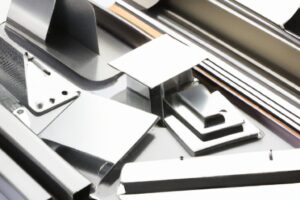Aluminium Sheet Metal Fabrication

Aluminium sheet metal fabrication is a versatile and widely-used process in the manufacturing industry. Aluminium, a lightweight and corrosion-resistant metal, offers numerous benefits for various applications ranging from automotive and aerospace to construction and electronics.
We are a leading aluminum sheet metal fabrication in China. We work with various aluminum alloy grades to match your preferences. KDM provides various fabrication services such as forming, cutting, bending, rolling, and stamping.
If you need custom aluminum sheet metal fabrication services, please don’t hesitate to contact us today!
Introduction to Aluminium Sheet Metal Fabrication
Aluminium sheet metal fabrication involves the shaping and forming of aluminium sheets into desired shapes and structures. This process typically includes cutting, bending, welding, and finishing to create precise components for different industries. Aluminium’s excellent properties, such as high strength-to-weight ratio, conductivity, and resistance to corrosion, make it a popular choice for fabricators worldwide.
Techniques for Aluminium Sheet Metal Fabrication
- 1. Cutting: The first step in aluminium fabrication is cutting the sheets to the required size and shape. Common cutting methods include shearing, laser cutting, and water jet cutting, each offering precision and efficiency in shaping the material.
- 2. Bending: Bending aluminium sheets is essential for creating curves, angles, and complex geometries in fabricated parts. Press brakes are commonly used to bend the sheets accurately to meet design specifications.
- 3. Welding: Joining aluminium sheets through welding ensures structural integrity and durability in fabricated components. Techniques such as MIG (Metal Inert Gas) welding and TIG (Tungsten Inert Gas) welding are employed to bond aluminium sheets seamlessly.
- 4. Forming: Forming techniques like stamping and deep drawing are utilized to shape aluminium sheets into three-dimensional parts with intricate details. These processes allow for mass production of components with consistent quality.
- 5. Finishing: Surface finishing techniques, including anodizing, powder coating, and polishing, are applied to aluminium sheet metal parts to enhance their appearance, durability, and resistance to wear and tear.
Considerations
- 1. Aluminium Grade: Selecting the appropriate grade of aluminium is crucial for ensuring the desired mechanical properties and performance characteristics of fabricated parts.
- 2. Design Considerations: Designing for manufacturability is essential in aluminium sheet metal fabrication to optimize the production process and minimize material waste.
- 3. Tolerances :+/-0.1 mm .Maintaining tight tolerances during fabrication is vital for achieving dimensional accuracy and part fitment in assemblies.
- 4. Material Handling: Proper handling of aluminium sheets is necessary to prevent damage and contamination that could affect the quality of fabricated components.
Applications
Fabricated aluminium sheet metal parts find extensive applications across various industries, including:
1. Automotive: Aluminium components are used in vehicle bodies, chassis, and interior parts to reduce weight and improve fuel efficiency.
2. Aerospace: Aircraft structures, panels, and components are often fabricated from aluminium sheet metal due to its lightweight and high strength properties.
3. Construction: Aluminium sheets are employed in roofing, cladding, and structural elements in the construction industry for their durability and aesthetic appeal.
4. Electronics: Enclosures, heat sinks, and components in electronic devices benefit from aluminium sheet metal fabrication for its thermal conductivity and electromagnetic shielding properties.
Conclusion
In conclusion, aluminium sheet metal fabrication plays a vital role in the manufacturing sector by offering a cost-effective and versatile solution for producing a wide range of components with exceptional properties. By leveraging the right techniques, considerations, and applications, fabricators can harness the full potential of aluminium sheet metal to meet the demands of various industries efficiently and effectively.
